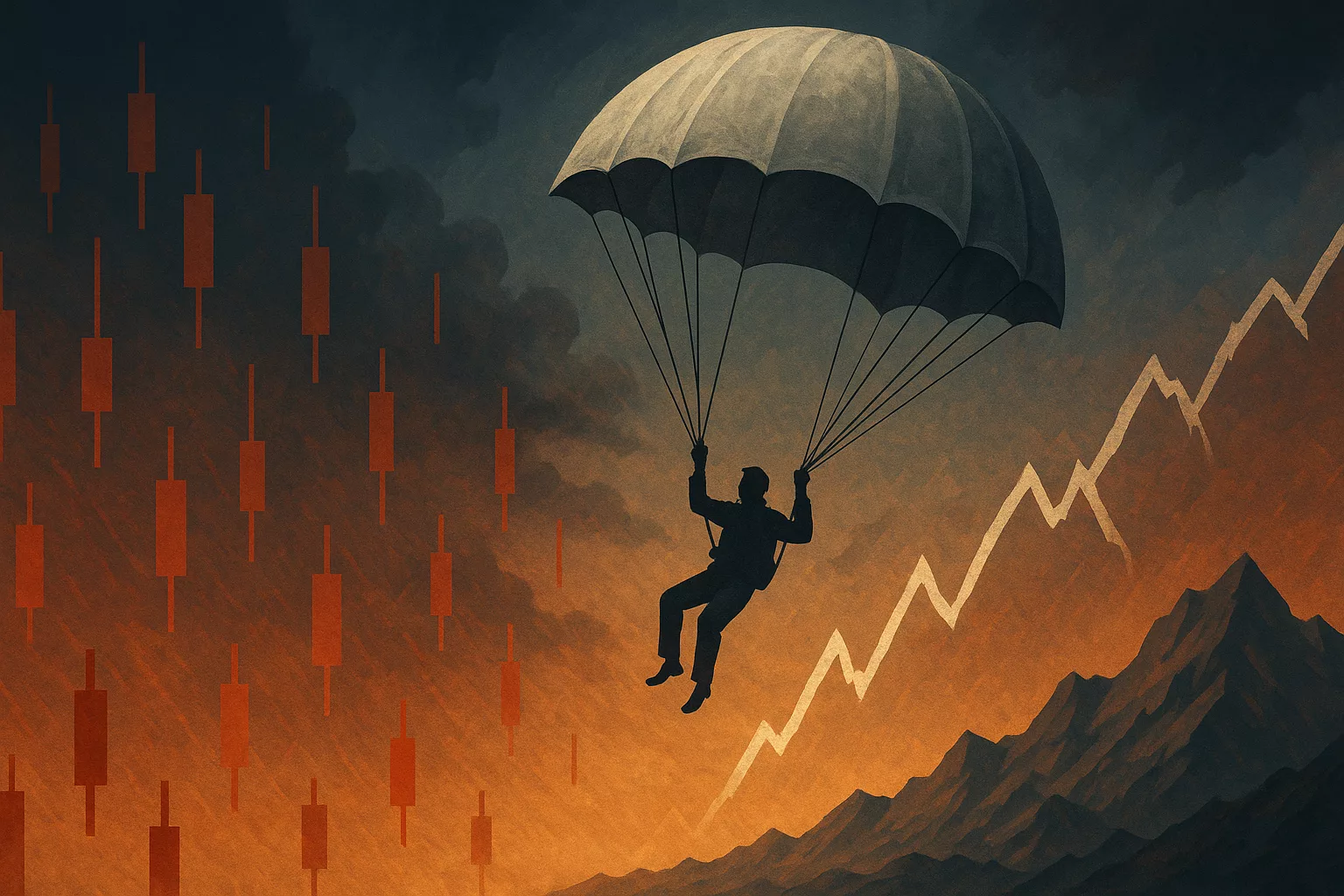It usually starts with excitement.
Imagine this: you’ve been following the markets for a while, watching a stock steadily climb, and one day you decide to finally pull the trigger. You buy in, and at first it feels great. The price ticks up, and you’re patting yourself on the back for making the right call. But then, almost out of nowhere, the stock drops. At first it’s just a little, nothing to panic about. But then it falls harder. You keep telling yourself it’ll bounce back, so you hold on. The losses grow bigger. Panic creeps in. Finally, when you can’t take it anymore, you sell—locking in a loss that wipes out weeks of progress.
If that story feels familiar, you’re not alone. Most traders experience it at some point. The difference between those who survive and those who quit comes down to one thing: risk management.
Trading stocks is thrilling, but the market is unforgiving. And without a solid risk plan, even the smartest trader eventually hits a wall. Think of risk management as your parachute. You might never need it on the way up, but when the market turns, you’ll be grateful it’s there.
Understanding Stock Trading and Its Implications
At its core, stock trading is the act of buying and selling shares of companies on exchanges like the NYSE or NASDAQ. But unlike investing, which is often about holding strong companies for years or even decades, trading is about seizing shorter-term opportunities. A trader might hold for weeks, days, or even just minutes.
The goal is to profit from fluctuations in price. But those same fluctuations are also the biggest danger. The market can turn on a dime due to an unexpected earnings report, a piece of breaking news, or a sudden shift in investor sentiment.
This is why stock trading is classified as a “Your Money or Your Life” (YMYL) activity by regulators and search quality raters. Topics in this category—like personal finance and health—can directly impact your security and well-being. That means accuracy and trustworthiness matter a lot.
There are real risks here. A trader who doesn’t manage exposure can lose far more than they ever expected. But history also shows that with the right approach, risk can be controlled.
- Successes: George Soros became legendary in 1992 when he bet against the British pound, making billions. But people often forget that he balanced bold moves with strict discipline about cutting risk elsewhere.
- Failures: Long-Term Capital Management, staffed with Nobel Prize-winning economists, imploded in the late 1990s. Their models were brilliant, but they ignored the possibility of extreme events. When the unexpected happened, they were overleveraged and collapsed.
The lesson? It’s not brains alone that matter in trading—it’s discipline.
The Foundation of Risk Management in Trading
So what is risk management in trading, really? It’s the art of identifying what could go wrong, measuring how much you can afford to lose, and building guardrails that protect you when trades don’t work out.
It doesn’t mean avoiding risk altogether. That’s impossible in markets. Instead, it means controlling risk so one mistake doesn’t destroy your account.
Why is this so critical? Three big reasons stand out:
- It keeps you in the game long enough to learn. Nobody masters trading in a month, and if you blow up early, you’ll never get there.
- It protects your capital, which is your lifeblood as a trader. Without money in your account, you can’t take advantage of future opportunities.
- It reduces emotional stress. Trading is already intense. Knowing you have safeguards in place makes it far easier to stay calm and rational.
And emotions are the silent killer in trading. Fear can make you sell too soon. Greed can make you hold too long. Regret can tempt you into chasing trades you missed. A proper risk plan keeps emotions from hijacking your decisions.
Building a Strong Risk Management Plan
Every successful trader has a risk management plan. Without one, you’re gambling. With one, you’re running a business.
The first piece of that plan is defining your risk per trade. Professionals usually risk no more than one to two percent of their account on a single trade. That way, even a streak of losing trades won’t wipe them out.
The second piece is setting realistic goals. Many beginners enter trading with dreams of doubling their money every month. The reality is that consistent trading is about slow, sustainable growth. Trying to force outsized returns usually leads to overtrading and oversized losses.
The third piece is position sizing. This simply means deciding how many shares to buy. Too many shares, and even a small dip can inflict massive damage. Proper sizing keeps risk manageable.
Finally, there’s the risk-to-reward ratio. Smart traders look for setups where the potential reward outweighs the potential loss. If you risk $100, you want the chance to make at least $200. This way, even if you’re right only half the time, you still come out ahead.
Recognizing the Risks Before They Bite
Let’s talk about the different kinds of risks traders face. The most obvious is market risk—the chance that prices move against you. But there are others, too.
Liquidity risk happens when there aren’t enough buyers or sellers for you to enter or exit smoothly. This is especially common in smaller, less-traded stocks. Execution risk occurs when your trade doesn’t go through at the expected price, often in fast-moving markets. That’s called slippage, and it can turn a good trade into a bad one.
Experienced traders reduce these risks with preparation. They track upcoming economic announcements and earnings releases. They check volume to ensure liquidity before entering a position. And they choose brokers with reliable order execution systems.
How to Minimize Trading Risks
Now comes the practical part: how do you actually keep risks under control? A few strategies stand out.
First, there’s diversification. Spreading your trades across different stocks or sectors means one bad trade won’t wipe you out.
Second, there are stop-loss orders. These are your safety nets. You set them at a price where the trade will automatically close if it moves against you. This prevents small losses from becoming devastating ones.
Third, there’s managing leverage wisely. Leverage can multiply gains, but it also multiplies losses. Many beginners blow up accounts by using too much leverage too soon. Think of it like adding rocket fuel to a car—it’s thrilling but dangerous if you don’t know what you’re doing.
Finally, there are tools and platforms that help you track risk in real time. Platforms like TradingView, Thinkorswim, and risk dashboards from brokers let you measure exposure and monitor your account health before things spiral out of control.
Lessons from Real-World Trading
The markets have taught us plenty of hard lessons.
- In 1987’s Black Monday crash, traders without stop-losses saw their accounts vanish in hours.
- In the 2010 Flash Crash, billions were wiped out in minutes as algorithms went haywire. Traders with strong risk controls survived; those without didn’t.
- On the brighter side, George Soros’s pound trade showed that bold moves can pay off—but only when balanced by rigorous risk discipline elsewhere.
New traders often repeat the same mistakes: they overtrade, they risk too much on a single position, and they abandon their own rules when emotions take over. Veteran traders avoid these pitfalls not because they’re immune to fear or greed, but because they respect their risk plans more than their feelings.
Adapting Your Risk Management Over Time
A mistake many traders make is thinking a good plan never changes. But markets evolve. Strategies that work in a roaring bull market might fail in a choppy sideways one.
That’s why it’s essential to review your plan regularly—monthly or quarterly at least. Ask yourself what’s working, what isn’t, and what needs to change.
Flexibility is key. A rigid strategy in a dynamic market is a recipe for frustration. The best traders adjust their risk levels, their position sizes, and sometimes even the types of trades they take depending on conditions.
And above all, they keep learning. The financial world never stands still. New technologies, new risks, and new opportunities are always emerging. Continuous education is part of long-term success.
The Long-Term Payoff of Risk Management
All this discipline pays off in three big ways.
First, it allows for sustainable growth. Small, steady gains compound into something powerful over time—but only if you avoid catastrophic losses.
Second, it builds resilience. Losing streaks are inevitable. With good risk management, they won’t end your trading career.
Third, it gives you peace of mind. Knowing that no single trade can destroy your account lets you trade with more confidence and less stress.
In trading, peace of mind is priceless.
Frequently Asked Questions About Risk in Trading
What is the failure rate of traders?
Between 70 and 90 percent of traders lose money over the long run. The main reasons are poor risk management and emotional decision-making.
What’s the hardest mistake to avoid while trading?
Overtrading. After a loss, many traders feel a desperate urge to win it back. This usually leads to more losses. Patience is hard but essential.
What is the biggest mistake traders make in risk management?
Risking too much on one trade. Even the best analysis can be wrong. Oversized losses can wipe you out in a single move.
What is the best risk management strategy for trading?
The most reliable framework is to risk no more than one to two percent of your account per trade, use stop-losses consistently, stick to trades with at least a two-to-one reward-to-risk ratio, and diversify your positions so no single idea dominates your portfolio.
Final Thoughts
Trading isn’t about finding a magic strategy that never loses. It’s about protecting your capital so you can stay in the game long enough to improve and succeed. Risk management won’t make you rich overnight, but it will keep you from going broke tomorrow—and in trading, that’s the difference between hobbyists who fade out and professionals who last.
So let me leave you with this: before you place your next trade, what one risk management rule will you commit to following every single time?

